With the opening of T2 of Pudong Airport, today, another terminal, T3 of Beijing Capital International Airport also opens. I am also lucky to experience the new terminal today.
Overview
The first impression of T3 is, it is HUGE! Look at the Google Satellite image below: T1 (opened in 1959) and T2 (opened in 1999) look so tiny compared to the big T3. The Google image is not updated yet. On the image, it is not completed, and now, it is open, and 60% of flights have already transited to T3.

Today, it is the largest terminal in the world, larger than the combination of the current four terminal in London’s Heathrow airport (the world largest airport).
By building area, it is also almost the largest building ever on earth, bigger than Pentagon in Washington D.C. More notable, it is completed within 4 years, which is pretty astonishing. According to Matt, one of the designer, their firm got the job to design the terminal 6 months before the construction actually started. Considering the Beijing Railway Station (Asia’s largest) took one year to built, and the city’s tallest building, World Trade Center, took only 1 and half year to complete, the short schedule of the airport seems OK in China’s standard.
Outside the terminal
The terminal is not very tall (at least seen from the runway), and you can hardly see them from the plane. It does not look very big from outside, does it? However, you will quickly find out you are wrong. It IS tall and it IS huge when you take a closer look.
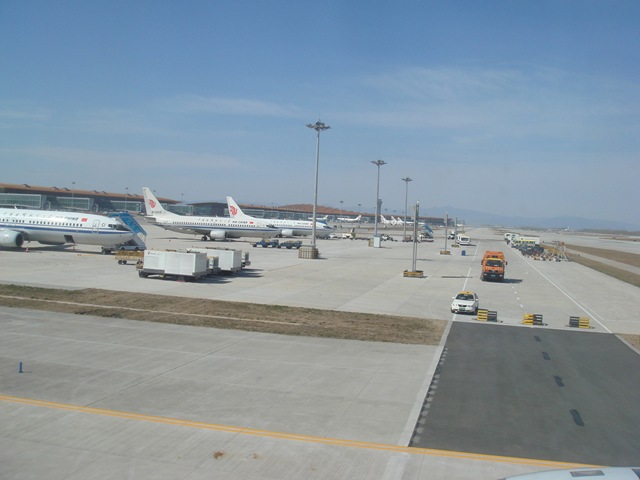
The first impression of the terminal for me is, it is a pine apple!
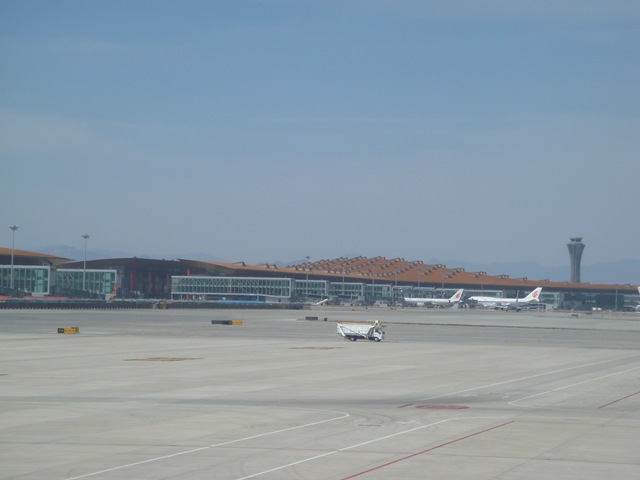
Another pine-apple picture:

Inside the terminal
To be honest with you, the dark orange color plus white is a little bit shocking for me. I didn’t expect Beijing to have an airport with this color. I don’t know why, but it reminds me of the airports in southeast countries – Singapore, Malaysia, Cambodia…
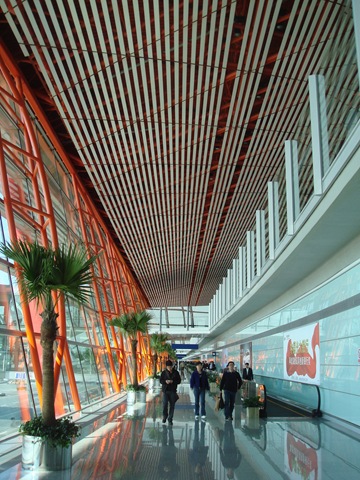
I am in the big curve of T3-C section.
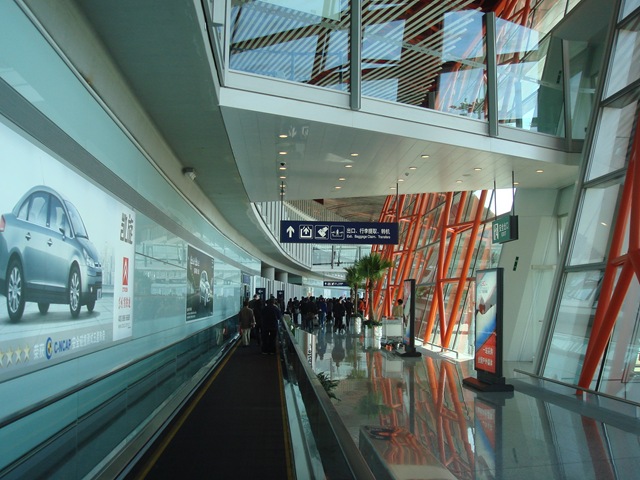
Looking back:
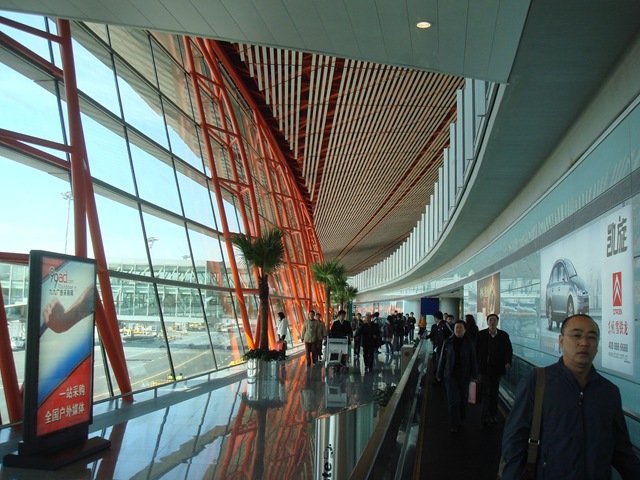
The package picking area is also pretty amazing. The hall is high and with strong ceiling decoration.
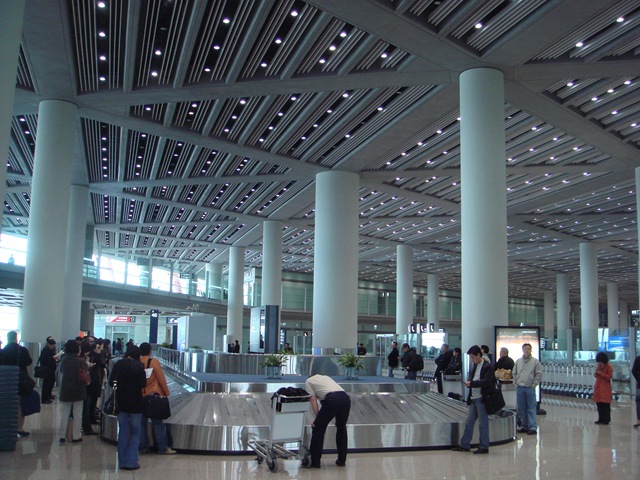
The direction board, as always, is pretty clear in Beijing Airport.

This is the diagram of the terminal.

This is the most amazing part – the departure hall – the biggest inner space in the airport.
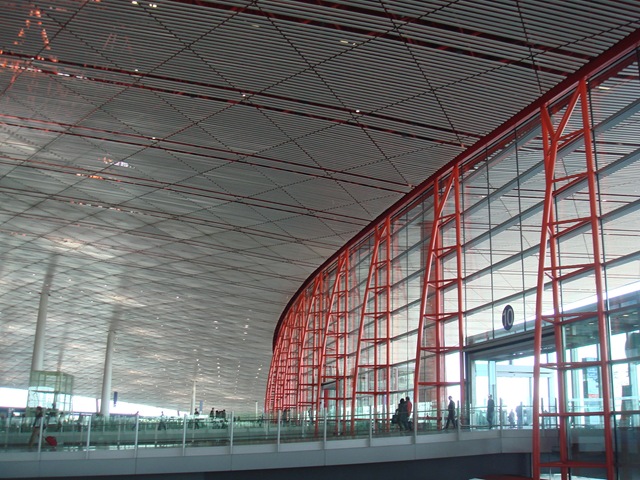
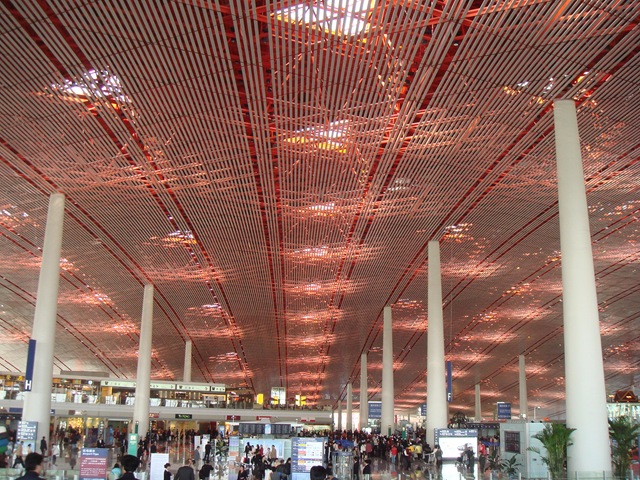
Look at the orange and reddish roof – what it reminds you? I thought about sky and galaxy when I first saw it.
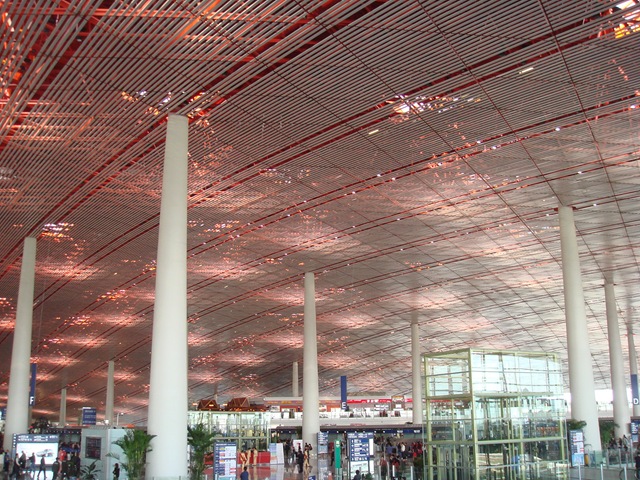
Parking 3
This huge architect is a parking building. It has more than 6000 parking space there. I have several photos of it. I also have a special entry on it: this huge project is not only a parking space, it is also the Beijing Airport Express Train station.

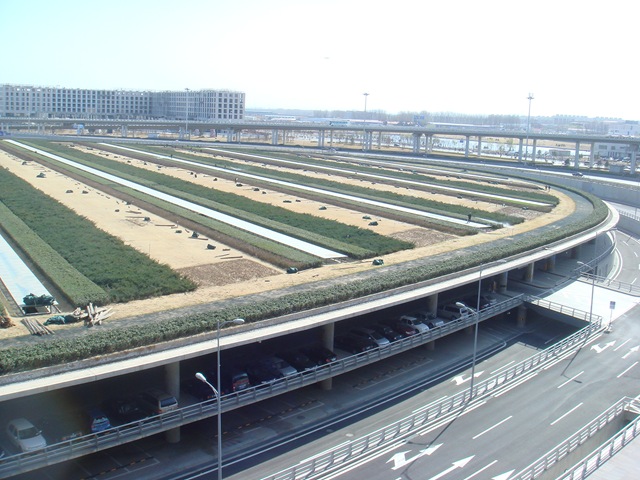

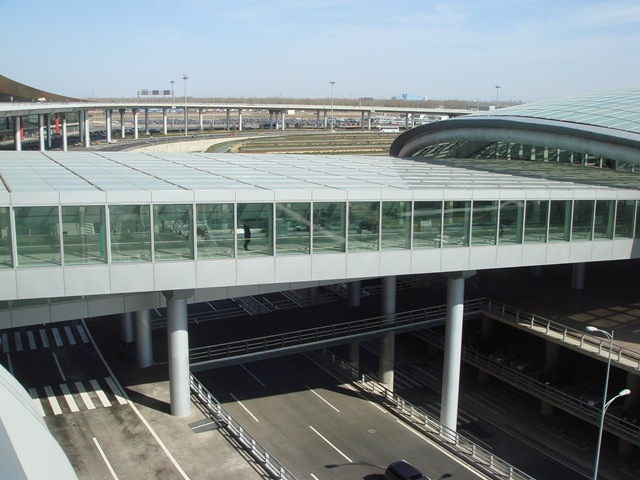

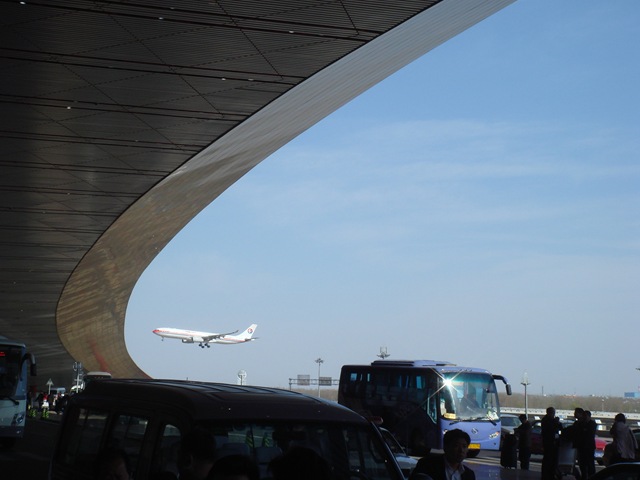
Summary
I didn’t have time to explore the Beijing Airport T3 as much as I did for the Shanghai T2. I will do more research and take more picture when I get back tomorrow. Beijing’s T3 is huge, out of my imagination.
With the completion (after four year’s construction) and open, it is another solid milestone for Beijing Olympics in 2008.
Good heavens! Two completely brand new terminals in one day? You are a pioneer!!
This building looks simply amazing — even more astonishing than the one in Pudong. I would be interested to hear what they are planning to do on the top of the parking structure where it looks like they are planting long rows of grass and shrubbery. A giant urban garden space perhaps? And, are the white sections between the green areas solar panels? Or possibly just lightly-covered open sections in the roof to allow natural light in to the top level of the parking garage? It’s very intriguing!
A very exciting day for you!!
Heathrow Terminal 5 opened here in London too! Been to the airport in Beijing… it was pretty grotty!
I will fly CA out of Beijing next Tue. I need to get to the T3 half an hour earlier than before, plus 20 mins longer on the road. I am not complaining, I do love to see a new terminal opened in Beijing.
@Carroll, the white pannel is not solar pannel. It is glass window, so it is not so dark in the parking lot. I have taken some pictures and will show the picture in the next entry.
I got some interesting comments on London Heathrow terminal 5’s launch by Lisa Minot, The Sun, 28 March.
Heathrow’s terminal 5 — which took 20 years to plan and cost 4.3m pounds — opened in chaos yesterday (27th March)
1. Passengers faced waiting hours for baggage.
2. Little information with display screens going on the blink and a lack of basics facilities such as catering and baby-changing.
3. Toilets were unfinished.
4. Escalators broke down. There were reports of families missing flights after two lifts jammed.
5. Some 35 outgoing flights were cancelled with 28 incoming ones.
6. Airport staff delayed to go to work for about 2 hours, coz not enough parking space.
7. Many airport staff cried for abused complains from upset passengers.
8. Staff complained that have not gotten enough training of the new baggage handle systems.
Bosses said servive today should ba back to normail. But that did not appear furious passengers.
I agree and love it! And thankfully Singapore Airlines (my country’s flagship carrier) is flying there from Singapore Changi Airport’s new Terminal 3 (opened in Jan 9 2008) to Beijing Capital In’l Airport’s Terminal 3! That is just too perfect. And to my surprise this terminal opened without a single hiccup (compared to London Heathrow Airport’s Terminal 5, which opened on the same day as Beijing’s)! See what Wikipedia says (http://en.wikipedia.org/wiki/Beijing_Capital_International_Airport):
Terminal 3
The construction of Terminal 3 started on March 28, 2004.It opens on February 29, 2008 and becomes fully operational on March 26, 2008, when Air China, Shanghai Airlines, other Star Alliance members, and other international airlines move in. It was designed by a consortium of NACO, Netherlands Airport Consultants B.V., UK Architect Foster and Partners and ARUP. The budget of the expansion is US$3.5 billion.
Far grander in size and scale than the existing terminals, it will become the largest airport terminal building complex built in a single phase with 986,000 sq. meters in total floor area. It will feature a main passenger terminal (Terminal 3A), two satellite concourses (Terminal 3B and Terminal 3C) and five floors above ground and two underground.
System, Security and Luggage
A 300,000-sq.m transportation centre is located at the front of T3. 7,000 car parking spaces will be available if the two-level underground parking lot is fully employed. The transportation centre will have three lanes for different types of vehicles, airport buses, taxies and private vehicles, which will enable a smooth flow of passengers. People bound for T3 will exit their vehicles here and enter T3 via an aisle within five minutes. The transportation centre will also have a light-rail station on a line that begins at the Dongzhimen stop on the Beijing Subway in Central Beijing. Travel time from Dongzhimen to T3 will be about 18 minutes.
There will be electrical outlets on either end of every row of seats in the terminal. There will be 243 elevators, escalators or moving walkways; and every restroom is accompanied by a mothers’ room where diapers can be changed. There is also a room for travellers with disabilities.
One of Terminal 3’s highlights is the US$240 million luggage-transfer system. The luggage system is equipped with yellow carts, each of which has a code, matching the bar code on every piece of luggage loaded on it, allowing easy and accurate tracking. More than 200 cameras will be used to monitor activities in the luggage area.
The luggage system can handle 19,200 pieces of luggage per hour. After luggage is checked in at any one of the 292 counters at Terminal 3A, they can be transferred at the speed of ten metres per second. Even for international routes, luggage can travel from T3A to T3B in five minutes. Arriving passengers should be able to begin retrieving their luggage within 4.5 minutes after airplanes are unloaded.
Along with X-ray scanners, additional equipment conducts checks such as for explosives. Passengers will be able to check in their luggage at the airport several hours or even a day before their flight. The airport will store them in its luggage system and then load them on the correct airplane.
The Look
A 98.3-metre monitoring tower stands at the southern end of T3, the highest building at the airport. The roof of T3 is red, the Chinese colour for good luck. The terminal’s ceilings use white strips for decoration and to indicate directions. Under the white strips, the basic colour of the ceiling is orange with light to dark tones indicating where a passenger is inside the building. It is light orange in the centre and deepens as it extends to the sides in T3B and is the other way round in T3A.
The roof of T3 has dozens of windows to let in daylight. Light angles can be adjusted to ensure adequate interior lighting. Many traditional Chinese elements will be employed in the terminal’s interior decoration, including a “Menhai,” a big copper vat used to store water for fighting fires in the Forbidden City, and the carvings imitating the famous Nine-Dragon Wall (Jiulongbi).
An indoor garden will be constructed in the T3B waiting area, in the style of imperial gardens such as the Summer Palace. In T3A, a tunnel landscape of an underground garden has been finished with plants on each side so that passengers can appreciate them inside the mini-train.
Facilities
The T3 food-service area is called a “global kitchen,” where 72 stores will provide food ranging from formal dishes to fast food, from Chinese to western, from bakery goods to ice cream. Airport officials have promised that people who buy products at the airport will see the same prices as in Central Beijing.
In addition to food and drink businesses, there will be a 12,600-sq.m domestic retail area, a 10,600-sq.m duty-free-store area and nearly 7,000-sq.m convenience service area, including banks, business centres, Internet services and more. At 45,200 sq.m, the commercial area will be twice the size of Beijing’s Lufthansa Shopping Centres.
Transportation between the three terminals
To get from Terminal 3A to 3B, Both domestic and international travellers will have to get boarding passes at T3A, but international passengers have to board from T3B. The two-kilometre trip between the two buildings is too far for walking, so the airport will have a free mini-train that shuttles between the two in three minutes.
To help passengers that go to the wrong terminal, the airport will provide bus transportation between T3 and the old terminals for free from 6 a.m. to 10 p.m. The buses set out every ten minutes from 8 a.m. to 8p.m., and every 20 minutes during other times.[16]
When completed, it will provide 66 more aerobridges or jetways – further complemented with remote parking bays which will bring the total of gates to 120 for the terminal alone. An additional runway is also projected to be constructed at that time. It will also have an extra capacity of 50 million people bringing the total to approximately 82 million passengers yearly. Upon completion, it is reported that passengers will be able to travel from the entrance of Terminal 3 to the farthest gate in less than 5 minutes.
It sounds like the Disneyland of airport facilities! If I am ever fortunate enough to fly in to this destination, I will be sure to leave at least a half day to explore the airport — as much a tourist attraction as the rest of the city, for sure :-)
truly a big building . i’m in awe of the structure and impressed by the ease of use . the shuttle train reduces the time and distance and also the frustration of arrival and transfer
I have just been back from Beijing’s new T3. As an engineer I can say that this structure it’s amazing and it can teach a lot to much more fanfared ones ended in squeaking noises as their music started. If a demonstration that things can be done at once and work properly since the beginning was needed T3 is the one. Same as no matter a building can be huge it can be accurately detailed and not just simply “impressing for the sight”. Even the smaller of the detail must have been born with the project since there are no visible signs of “patches” made to fix problems. There is always something to learn.
I have just been back from Beijing’s new T3. Love the airy space with tall ceiling, and the sunroof that let the sunshine into the garage.
The coffee shop sound good if there would be no carbon monoxide from the car exhuast pipes.
This is just the most amazing gateway into the fastest growing nations in the world. Really looking forward to going through this brand new wonder in August on my way to the Games. They say that will be the games to end all games. I’ll be there to see it.
I love the photos. The overhead view says it all. Amazingly, I’ve read that Bejing may need to build a second airport to cope with the demand. (See The Economist for the article).
I’ve done a comparison of Bejing with two other recently opened airports, Tianjin BinHai Airport and Heathrow Terminal 5. Bejing beats them both hands down.
New Airport Comparison
Can anyone tell me why the Chinese build everything so big? God!
Hi Jian Shuo… as you know, I am a very frequent business traveller. As fate has dictated, this week was only the first time that I got to use the International arrivals and departures of the new Terminal 3, and my impressions are this:
Firstly, the architecture and size etc are really amazing… a job well done.
As far as the logistics are concerned, they have a very, very long way to go in order to get ready for the 2008 Olympic visitors.
I arrived at T3 in Beijing on a red-eye flight from Singapore (SIA) at 7:20am on Tuesday morning. Due to the class travelled, the status of my kris flyer membership, and the APEC card I hold to move through the diplomatic channel at immigration, I was the first to arrive at the baggage collection – so far no problems. After collecting my bag from the carousel, I was the first to head toward customs to exit the terminal. This is where things went very wrong. The signage (of which there is very little) for arrivals is very misleading. After asking a security office for directions to customs, I ended up in a queue, and after 10-min waiting was asked for my boarding pass. When I explained that I was arriving, the attendant could not speak english and my mandarin was too poor for her to understand. She called another security person to talk to me, who then advised that I was in fact on the wrong floor – I needed to leave floor 2 and go to floor 4. Even though I was dubious about this, I got on the elevator to floor 4, where I exited into the main part of the terminal (in departures) with absolutely no security or customs check – lucky I was not a terrorist or drug trafficker!!
Then I had to cross to the other side of the terminal, get an elevator back to the 2nd floor (where I saw that I was on the outside of the customs area), and an escalator ride down to where I eventually caught a taxi – total time after collecting baggage was about half hour, and no security checks – as a traveller who visits numerous airports, this was a very daunting and amazing experience for me – goodness knows what infrequent travellers will go through in August??
When I was departing – I went up the diplomatic channel again at immigration… this time there was no-one in attendance, and once I was on the other side (unchecked), I had to ask someone at baggage scanning to get someone to go back and stamp my passport for me (which they did) – otherwise they would think I was still in China.
Once I cleared immigration and baggage scan, I headed up to the BGS premier lounge – the common lounge for nearly all airlines – only to discover that the wireless internet connection was not working – I was advised that they had not finished setting it up… I lost 2 critical hours that I needed to complete some urgent work. I sat there frustrated with a huge number of other business people looking at laptops with no online access…
In all, I was very disappointed with the experience, after all the hype… I was looking forward to visiting T3… my colleagues that also landed in to Beijing this week all had similar (or even worse) experiences… I sincerely hope that they fix all the bugs before the Olympic traffic hits… it doesn’t matter how pretty or state of the art the design, runway, architecture ete etc is, without the proper logistics and support for the traveller, it’s similar to travelling through sub-standard airports like those in India.
Disappointed!!!!
As for the wireless internet access, I though that virtually all senior expat managers frequently travelling to or based in China are equipped with a GPRS card that enables internet access everywhere and 24/7. Isn’t this the case? Compared to all other expat benefits, the cost of the card and the monthly fees charged by a Chinese provider are outright tiny.
No this is not the case, DB… I have never experienced no wireless access at any airport in the world in the last 2 years (except for India). We were all talking in the lounge, and we all had the same problem. All told, about 30 of us. The airport management were very aware of the problem and very apologetic, but that did not help any of us. This is an absolute ‘gimme’ as far as basic requirements of a business lounge at an international airport and MUST be rectified.
No one in any of the multinational companies (at any level) for which I’ve worked has a GPRS card (with the exception of some lower level sales people who travel internally in their country but not internationally, and operate remotely nearly 24/7 on the road with no office to attend) – we have smart phones with GPRS so we can do email, but this does not enable VPN access to company networks and infrastructures.
As an aside, you will see that most multinationals are beginning to move away from ‘expat’ packages and overseas assignments are paid via local means (albeit very good packages).
Hi AussiePB,
Interesting to read your remark on foreigners being paid local packages. I’ve recently come across this term more frequently.
However, I understand that local packages are not the same as what a real local gets, but are rather – as indicated by you – almost as generous as expat packages. Oftentimes they include tax-equalization + tax advice, continuation of home country social security coverage, home flights, maintenance of foreign residence permit if employee is Chinese or TCN, etc. All these components make a local package (or a package under Local+ policy, as they are sometimes called) look pretty similar to an expat package. Hence, I wonder what the fundamental difference is between these two types of packages. From an employee’s perspective, the difference seems not very significant at first sight.
I could imagine the following:
1. Contract is signed with Chinese entity, not foreign entity.
2. Salary (be it home currency, RMB or a combination of both) is paid by Chinese entity, not foreign entity.
3. Assignment is indefinite in length.
4. No guarantee for a job if employee wants to return to home country.
If these are the main differences, I think only no. 4 really matters. Can you please correct me if I’m on the wrong tack?
Hi DB – good to hear from you – I think to answer your question, it totally depends on the company one works for and the package offered. Sorry for the long-winded response following – so difficult to explain all the nuances without citing some of my own experiences…
The package you described seems very attractive indeed – if this was offered to me, perhaps I’d think about switching jobs!
The reason many MNCs are opting away from expat packages is so as not to be liable for many of the elements to which you have referred (to increase shareholder sat and earnings). The tax advantages of accepting a local package is one of the biggest benefits for me, and I do get tax advice as part of my package, however I really wish tax-equalization was on the table. Then I would not have had to liquidate all of my assets in Australia (inc. property, shares, etc) so as to avoid any income from there, and remaining an Australian ‘tax resident’. And yeh, my salary is much, much more than a local in a similar role – it needed to be for me to move my whole life.
Of course, my experiences are specifically referring to Australian citizens…
Once one opts to become a non-tax resident like I have (and most Aussies working in SG within the same company for which I work – otherwise, no tax advantage, no sense in relocating financially), one forfeits any social security coverage, medical benefits etc back in Aust… so I had to ensure that part of my package was a strong local healthcare scheme… as a SG income earner, I am only earning the nominal CPF capped amount for retirement as opposed to the very attractive superannuation schemes mandated by the Aust govt…
Annual leave is around 25% less than if I was on an expat package, I don’t receive ‘R&R’ (1 week every three months vacation with airfares included), local housing provision, driver and car….. and many other things included in standard expat packages. After 1st year or two, foreign residency status obligations are passed on to the employee – specifically in SG, this introduces a whole new slant… does one stay as a P1 (professional employee from a foreign country), or does one apply for PR (permanent resdient status) which offers further tax advantages? If one was to go ‘all out’ and become a SG citizen – substantially less tax to pay again… we have opted for PR, because without it, we would’ve needed to keep paying the HUGE rental amounts in SG for accomodation – unless one is PR status, one is not allowed to purchase an apartment of any kind – even as a PR, the best we can do is condo apartment or 5-yr old HDB apartment (one is not eligible for the same as citizens). Nor can a PR purchase ‘landed property’ regardless of money in the bank, money earned, assets owned or anything else.
The biggest downfall to becoming PR is the fact that our son is now liable for Singapore NS (National Service)… if we decide to leave SG before his time to serve arrives, then the liability goes away (along with our PR status), and the really unfortunate thing there is that although he may have done nearly all his schooling in SG, there is a good chance the govt will never again allow him to work or study in SG because we have revoked his NS liability by leaving the country – this is a choice I’ve had to make for my son, even though he’s now only 10-months old, but it could effect the rest of his life.
Anyway, you probably think I’ve gone way off topic, I think I could go on and on for a long time (you’ve stated four points around the differences between expat vs local packages, but I could probably come up with at least another 100+ that I needed to take into account – and still considering now, years later – when relocating my family and entire life to a different country).
The important thing to note, is that all the things (and more) that I’ve mentioned above, salary related, family related, residency status, etc all become relevant when on a local package – if I was an expat, I’d just accept the benefits, keep all my assets in Australia, bank nearly all my earnings, never pay for housing or transport or education at the top private international schools or travel, enjoy better vacations with free travel… then head back to Australia at the end of assignment a much, much wealthier individual…
Take care, my friend – hope this answers your question?
Hi AussiePB,
Thx for your lengthy yet informative response! Certainly employees have far more than four factors they need to consider before deciding on whether to relocate to another country, and your description offers a great amount of insight into the thought process.
As for your package itself, I understand that it’s been designed to let you relocate to Singapore for an indefinite period of time or for good, so no. 3 and 4 of my points above are verified. This is the main thing I wanted to know because this effectively means a break of the ties with one’s home country in many ways such as employment, social security & pension, taxes, not to mention the more private aspects and all attendant implications.
As a matter of fact, there is something well-established already in between a traditional tax-equalized BS assignment and the local package you describe (which I have otherwise seen being labeled as a “Local-to-Local-Transfer”), namely a so-called “Local Terms Assignment”. The main characteristic of this policy is that you are treated as a very well-paid employee under local terms, but from a legal perspective retain your home country employment and therefore have “expat” status and the right to return after your assignment ends. You get no housing allowance, no home flights, no tax-equalization etc. The only real expat components are continuation of home country social security & pension fund contribution (if applicable) + global health insurance.
This might be favourable depending on the home and host location. For China, this would be impractical due to the high tax rates. But for employees from high-tax locations like Germany going to Singapore, it would definitely make sense because the tax burden is much lower and capital gains are not taxed, while the CPF contribution is tax-deductible and will be refund incl. interest when the employee leaves Singapore. This “Local Terms” assignment policy makes even more sense when sending people to tax-free locations such as Panama or Nassau because there they pay no income taxes at all while retaining their home country links and the right to return.
I have a 14 hour layover from SFO to NNG arriving 10-24-12 is there a rest-room provided at a rental rate? Thankyou